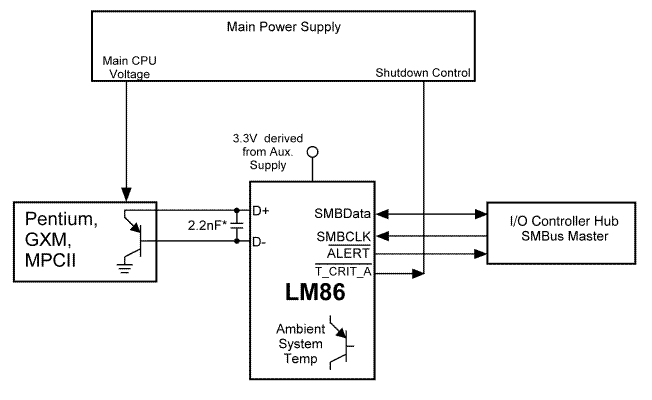Accessing an SX semiconductor junction?
Im pretty sure this isn't possible, but do any of you know the actual transistor layout of·SX pins·to know if a diode junction can be isolated (access to an n-channel in a p-well or p-channel in n-well) by an external chip? Im just wondering if the LM86 can be used with an SX, heres an except of the specification:



Comments
Good Luck,
Mr. T
Post Edited (Paul Baker) : 6/17/2005 11:39:06 PM GMT
You might be able to use the internal 4MHz clock as a temperature monitor.
The internal clock changes with temperature and you could probably calibrate it at several temperature points then read the frequency and tell what the temperature is.
Or maybe not...
Bean.
▔▔▔▔▔▔▔▔▔▔▔▔▔▔▔▔▔▔▔▔▔▔▔▔
"SX-Video·Module" Now available from Parallax for only $28.95
http://www.parallax.com/detail.asp?product_id=30012
Product web site: www.sxvm.com
"What's the difference between ignorance and apathy ?"
"I don't know, and I don't care."
·
▔▔▔▔▔▔▔▔▔▔▔▔▔▔▔▔▔▔▔▔▔▔▔▔
Hmmm,
How about somehow timing from the watchdog timeout ? That runs from a 14KHz internal oscillator that I assume will vary with temperature also (I think even more so than the 4MHz).
In the program you could Reset the watchdog and send out a pulse, then just wait for the watchdog to expire which will reset the chip and have the startup code send out another pulse.
The time between the pulses is inversely proportional to the watchdog clock speed.
Bean.
▔▔▔▔▔▔▔▔▔▔▔▔▔▔▔▔▔▔▔▔▔▔▔▔
"SX-Video·Module" Now available from Parallax for only $28.95
http://www.parallax.com/detail.asp?product_id=30012
Product web site: www.sxvm.com
"What's the difference between ignorance and apathy ?"
"I don't know, and I don't care."
·
The ESD diode method would only work if you completely disconnected everything else from the SX chip. Since the ESD diode's are reverse biased you need to flip your D+/D- terminals
around on the LM86 to do it this way. Not a practical approach since it defeats the purpose, sorry.
▔▔▔▔▔▔▔▔▔▔▔▔▔▔▔▔▔▔▔▔▔▔▔▔
Beau Schwabe
IC Layout Engineer
Parallax, Inc.
Mulling this idea over....what if you completely electrically isolated the LM86 except for what's allowed at the D+/D- terminals?
In other words it's own power supply with nothing shared. You still would need to reverse the polarity of your D+/D- pins to your
SX. If you setup a pin as an input, and connect D- to the input and D+ to the SX VDD or D+ to the input and D- at SX VSS, you
should "see" the ESD diode. As far as reading/driving the signal from the LM86, you will need to optically isolate them. The
SMBData signal might be tough, but a dedicated SX that just talks to the LM86 and then through an opto isolator to a PC might be
a solution.
One thing to note.... The ESD diodes are part of the PAD structure and every pin should have them (except rare special cases).
That said, there may be a considerable distance in terms of silicon from the PAD and the actual area of silicon generating the
most heat. I would map several pins to determine if there are indeed "hot spots" that a single pin may not be able to register.
▔▔▔▔▔▔▔▔▔▔▔▔▔▔▔▔▔▔▔▔▔▔▔▔
Beau Schwabe
IC Layout Engineer
Parallax, Inc.